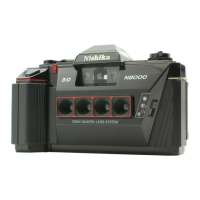
Do you have a question about the Nishika N8000 and is the answer not in the manual?
| Film Format | 35mm |
|---|---|
| Shutter Speed | 1/60 sec |
| Focus | Fixed focus |
| Exposure | Automatic |
| Film Advance | Manual |
| Flash | Built-in flash |
| Lens | 4 x 30mm f/8 fixed-focus lenses |
Details of the camera's components and their operational roles.
Describes the patented Quadra Lens design and its features.
Explains how to adjust the lens diaphragm for light control.
Describes the function of the button that triggers the shutter.
Explains the lever used to advance the film to the next frame.
Indicates the number of exposures taken on the film.
Provides a connection for external flash units.
Details the mechanism for rewinding film and opening the camera back.
Explains the viewfinder for composing shots and framing the image.
Covers take-up spool, sprockets, pressure plate, and camera back.
Describes the battery housing and the rewind shaft.
Details the film chamber and the thumbwheel for film loading.
Instructions for accessing the battery compartment.
Correct method for inserting AA batteries into the chamber.
How to use the tester switch and indicator light.
How to open the camera back to access film loading.
Attaching the film leader to the take-up spool.
Placing the film cartridge into the film chamber.
How to advance film and set the exposure counter for the first picture.
Understanding how the counter tracks 3-D exposures.
Essential instruction to hold camera horizontally for 3-D effect.
Adjusting aperture based on lighting conditions for proper exposure.
How the red light warns of insufficient lighting.
Composing shots using the viewfinder and taking the photograph.
How to disengage the film mechanism for rewinding.
Steps to turn the crank and rewind the film.
How to open the camera back and unload the used film.
Proper care, cleaning, and storage of the camera body and lenses.
Advice on handling prints and negatives to preserve quality.
Key principles for composition, including orientation and distances.
Advice on foreground overlap, lighting, color, and indoor shooting.
Specific guidelines for capturing subjects effectively.
Resolving problems with film movement and shutter operation.
Addressing issues with battery indicators and exposure errors.
Resolving problems with film rewinding and exposure counter reset.
Solutions for unsatisfactory prints and fewer prints than expected.